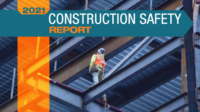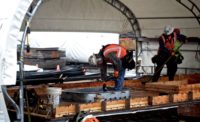Two of the three union ironworkers who died on the job last year had used fall protection equipment that failed because it was not applied correctly, said Eric Dean, general president of the International Association of Bridge, Structural, Ornamental and Reinforcing Ironworkers.
“To get across a beam, you use a beamer that allows horizontal egress back and forth, left and right,” Dean told attendees at the 2023 North American Ironworkers/IMPACT conference held Feb. 12-15 in New Orleans. “To go up and down columns, they have vertical fall retractable lifelines. What we're seeing is: a lot of our companies are providing vertical fall arrest equipment, but they're tying off and using it horizontally. When you're out 20 feet extended, you're not going to limit your fall.”
As part of its efforts to eliminate steel erection worksite hazards, the union recently obtained accreditation from International Accreditation Services, which is part of the International Code Council, for two training programs, IMPACT leaders announced at the conference. The union also launched a new fall protection training program aimed at forepersons and superintendents for which the Ironworkers’ safety and health department is also working to obtain third-party certification from IAS, Dean says.
The new fall protection training program, which Dean said the union plans to next offer in July at its annual ironworkers instructor course in Ann Arbor, Mich., is a free course presented in partnership with 3M. Fall protection specialists from the company provide technical information in a classroom setting and conduct hands-on applications on a fall-protection training structure.
The new course was developed in part because of requirements from big project owners that are requiring greater safety results, said Steve Rank, union executive director of safety and health. While there are other safety certifications available, he said they are not industry-specific like this.
Dean said many training facilities that were designed 15 or more years ago do not have structure that lends itself to some of the latest safety training methods. Leaders are auditing union schools, he added.
“The equipment today is so much more advanced than it was five years ago, 10 years ago, let alone 20 years ago,” Dean said.
The ironworkers union also earned IAS accreditation for its rigging and signal-person certification program and for its safety director training course. The rigging and signal program was designed to meet certification requirements set by many contractors, states and municipalities, according to the union. Eligible union members can contact their local training center for information about testing for the certification.
The safety director training course includes 40 hours of classroom instruction over five days, presented by 10 subject matter experts, said William Brown, executive director of Ideal Contracting and contractor co-chair of IMPACT. It is aimed at new, experienced or future ironworker safety directors who are already qualified journeymen with strong safety skills, as well as at IMPACT signatory contractor safety directors.
“Since its inception in July of 2016, 570 members and contractor safety representatives have completed this course,” Brown said.
The next safety director certification course is scheduled for June 12-16 at Ironworkers Local 63 Training Center in Broadview, Ill.






Post a comment to this article
Report Abusive Comment